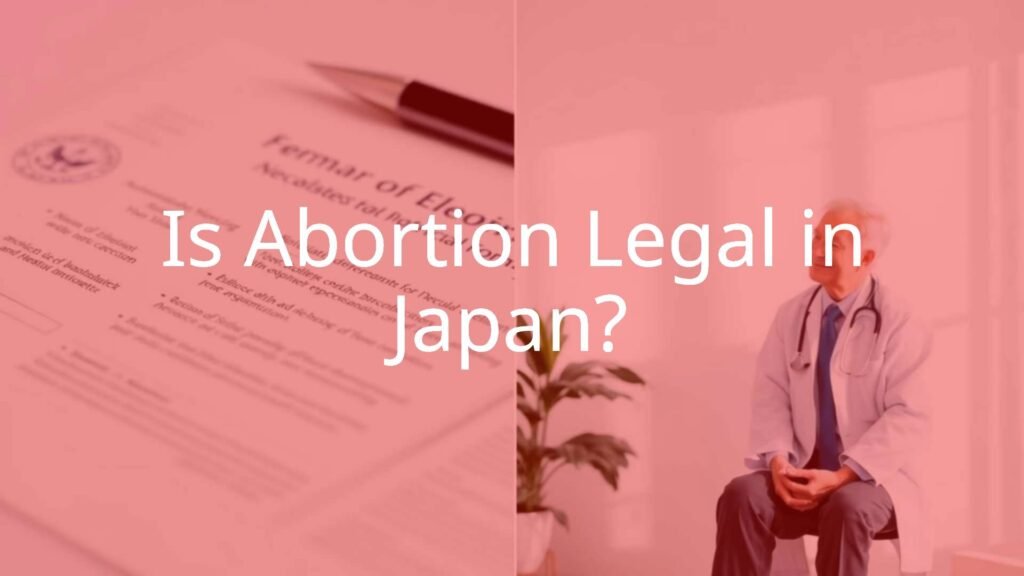Yes, abortion is legal in Japan, but only under certain rules. The Penal Code of Japan says abortion is illegal, but the Maternal Health Protection Law lists exceptions where abortion is allowed. This means that although the law starts with a ban, there are clear ways to get an abortion if the woman’s health is in danger, due to financial difficulty, or if the pregnancy is from rape. Japan’s system has its own unique rules, especially when it comes to consent and access, making it stand out compared to other developed countries.

Is Abortion Legal in Japan?
What Are the Current Abortion Laws in Japan?
Abortion laws in Japan have two sides. On one side, Chapter XXIX of the Penal Code calls abortion illegal. On the other hand, the Maternal Health Protection Law allows abortions in several situations. These exceptions make abortion common and accepted in practice. So, while the letter of the law says abortion is generally banned, this is not how it works in real life because the Maternal Health Protection Law gives specific reasons and time limits for legal abortions.
Abortion is allowed up to 22 weeks of pregnancy if the woman’s health is at risk, if she cannot afford to raise a child, or if the pregnancy came from rape. The financial reason is often interpreted in a wide way, so many women qualify under this rule. Until recently, only surgical abortions were permitted, but since April 2023, abortion pills can be used up to 9 weeks of pregnancy, offering a new option, though somewhat limited.

What Is the Maternal Health Protection Law?
The Maternal Health Protection Law (No.156 of 1948) is the main law covering abortions in Japan. Introduced in 1948, the purpose of this law is to protect women’s health by making rules about sterilization and abortion. This law took the place of the older Eugenic Protection Law, which focused on stopping the birth of children with disabilities.
Under the Maternal Health Protection Law, approved doctors can perform abortions if being pregnant puts a woman’s health at risk (physically or financially), or if pregnancy is because of rape. Article 14 says that both the woman and her spouse must agree if they are married. This rule about the husband’s permission is often debated. Exceptions exist for some cases, like unmarried women or those in dangerous relationships, but many clinics still ask for the man’s signature. When the old law was changed in 1996, it removed all eugenic ideas and focused only on women’s health and safety.
History of Abortion Legislation in Japan
How Have Abortion Laws Changed Over Time?
The story of abortion laws in Japan shows how attitudes and concerns have changed over the years. Abortions were first banned during the Edo period in 1842. The Meiji government also wanted a bigger population for national strength, so strict bans stayed in place. The first penal code in 1880 made abortion a crime, with penalties growing tougher over time. By 1907, women could face one year in jail and doctors up to seven years for performing abortions.
Things started to change in 1923 when emergency abortions to save the mother’s life became legal for doctors. By the 1930s, groups like the Alliance for Reform of the Anti-Abortion Law pushed for women’s rights to decide. These movements, along with support from events like the Fifth All-Japan Women’s Suffrage Congress in 1934, led to new ideas about legalizing abortion.

Key Changes and Updates Since 1948
After World War II, Japan faced a population crisis, so the government made big changes. The Eugenic Protection Law in 1948 allowed abortions for certain reasons, especially to prevent starvation and other population problems made urgent by cases like Miyuki Ishikawa’s. In 1949, the law was changed to include mental and financial distress as reasons, and by 1952, poor living conditions were also allowed as a reason.
In 1996, the law lost its eugenic focus and was renamed the Maternal Health Protection Law to underline protection for women, not state control. Over the years, the number of abortions has gone down a lot (from over one million in 1960 to 145,340 in 2020). The latest update was in April 2023, when Japan approved the abortion pill for use in pregnancies up to 9 weeks, but it comes with rules like hospital stays and spouse consent.
Legal Requirements and Procedures for Abortion
Who Can Get a Legal Abortion in Japan?
Who qualifies for an abortion is clearly stated in the Maternal Health Protection Law. A woman can have an abortion if her health (physical or financial) is at risk or if pregnancy is from rape. The rule about financial hardship is often used and between 1975 and 1995, almost all legal abortions listed health protection as the reason, which includes money issues.
Even with these rules, the actual steps can be hard. Foreigners are not excluded, but language and procedure differences can be obstacles. Usually, hospitals ask for several visits: one for an exam, another for the procedure, and a third for a check-up. Hospitals may set extra requirements, making the process not just about meeting legal rules, but also being able to handle the practical side.
Consent Rules for Abortion
Getting permission is one of the most debated parts of abortion in Japan. If a woman is married, her spouse must agree for the abortion to go ahead, especially when the reason is money. This rule can be a big problem for many women. While the Health Ministry says exceptions exist (for example, in abusive marriages), most clinics still demand the partner’s signature to avoid legal trouble, even when it’s not always required by law.

Japan is one of only 11 countries in the world, and the only G7 nation, to need spousal consent for abortion. In practice, even unmarried women can face this demand, making it difficult and emotional for some. If the woman is under 18, a parent or guardian must sign. While the law allows a woman to sign for herself if the partner is unknown, in reality, clinics often want more proof, making the process stressful.
Gestational Limits and Allowed Reasons
The law states abortions can happen up to 22 weeks of pregnancy (21 weeks and 6 days after the start of the last period). After that, abortion is only allowed to save the mother’s life. This limit matches when a fetus can generally survive outside the womb.
The three main allowed reasons are: risk to the woman’s health (including financial problems), and pregnancy by rape. Having a fetus with abnormalities is not listed as a reason in Japanese law, so even if a scan finds a serious issue, doctors must use one of the already listed reasons (usually financial or physical risk) to go ahead with an abortion. This sets Japan apart compared to some other countries.
| Condition | Is Abortion Allowed? |
|---|---|
| Up to 22 weeks, health risk (physical or financial) | Yes |
| Up to 22 weeks, pregnancy from rape | Yes |
| Up to 9 weeks, medical abortion (abortion pill) | Yes (since April 2023) |
| After 22 weeks, unless to save the mother’s life | No |
| Fetal abnormalities | No (not a stated reason) |
Frequently Asked Questions on Abortion Legality in Japan
Can Foreigners Get an Abortion in Japan?
Foreign nationals living in Japan can get abortions, since the law applies to everyone, not just Japanese citizens. But there are some extra challenges. Language can be a major problem, as not all doctors speak English or other languages. It’s a good idea to bring an interpreter to help you understand everything and complete consent forms. Groups like AMDA and Himawari can provide medical information and sometimes help with interpretation.
Foreigners also have to follow all the same rules, including the need for a spouse’s signature if married. Not all clinics accept exceptions, even with Health Ministry advice. Also, the cost is not covered by insurance and payment is usually in cash. A surgical abortion costs 100,000-200,000 yen, and the abortion pill is around 100,000 yen, with an added cost for a hospital stay. These extra costs and requirements mean foreign residents need to prepare carefully.

What Happens if an Abortion Is Done Illegally?
If an abortion takes place outside the allowed situations, it is considered a crime under Japanese law. The penalty from Section 212 of the Penal Code is up to a year in prison, although this is rarely used, because most abortions legally fall under the wide “economic rationale” exception.
Those who perform abortions without proper approval or without the woman’s agreement can face prosecution. Only certified gynecologists or obstetricians can do abortions, and illegal use of abortion drugs is also a crime. With the abortion pill, women must take it in hospital under a doctor’s watch; taking it at home is prohibited. Breaking these rules can bring up to a year in prison, and the government takes this seriously to avoid misuse or black market problems.
- What Is a Maiko? - July 13, 2025
- What Does Domo Arigato Mean? - July 12, 2025
- What Does Naruto Mean? - July 12, 2025









